
4.3 VAM - the beneficial fungi that feed plants
by Sally Smith, University of
Adelaide
Most plants do not just have
roots, they have VAMs - vesicular arbuscular mycorrhiza.
VAMs are fungi which live in a harmonious relationship with plant roots.
This is a symbiosis in which the fungi provide the plant with extra
nutrients from the soil, especially phosphorus and zinc, in exchange for sugars
provided by the plants.
About 80% of all plants,
including most field crops and many trees, harbour the fungi as an integral and
normal component of their root systems.
As with all fungi VAMs also
help hold soil particles together.
How VAMS live
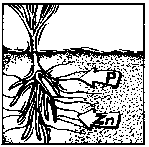 |
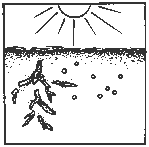 |
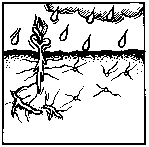 |
|
VAM fungi grow inside plant roots. Hyphae absorbs
nutrients beyond the reach of roots. |
Summer: plants absent. Fungi survives in the dead
root fragments or as large spores. Fungi are dormant when soil is
dry. |
After rain VAM germinates from dead root fragments
and spores-colonising new roots. |
There are about 150 species
of the fungi, which may have small preferences for different soil types and
environments, but in general they are all capable of colonising roots of all
susceptible plants (see Table 1 for susceptible/host crops), which is an
important factor in their management.
Some plants, especially trees
like Eucalypts, orchids and some heathland shrubs, have a different type of
symbiotic fungus which works in a similar way to VAM. If you are interested in revegetation you also need to
consider the range of different beneficial fungi that may be important.
Can I see VAM in soil or roots?
VAMs cannot be seen unless
the root is stained and viewed under a microscope.
The VAM fungi do not cause any disease, so there is no discolouration or
root distortion. This makes it
difficult to determine whether they are present in the roots or the soil.
However, the chances are they will be there and working to improve the
nutrient uptake of your crops and the stability of your soil.
Lack of VAMs will reduce
plant growth, but this again may be hard to determine in a paddock situation.
Figure :
Mycorrhizal (VAMs) and phophate responses in low phosphorus soil.
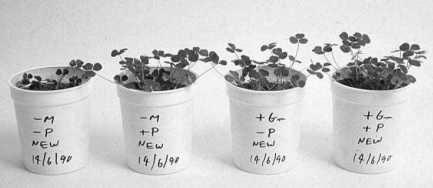
How does the fungus-plant relationship
work?
VAMs extend the plant root
system and the whole mycorrhiza (fungus plus plant) can exploit the soil
nutrients much more effectively than the plant alone.
|
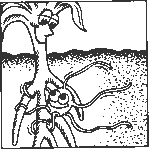
VAM grow inside the roots. They extend beyond
the zone o nutrient depletion. They provide a rapid transit system
for poorly soluble nutrients. |
Some plant nutrients, such as
phosphorus (P) and zinc (Zn), move very slowly in the soil solution.
Therefore, when a plant removes these nutrients from the soil near the
root, there can be a delay before they are replaced at the root surface.
A zone of nutrient depletion may occur near the root slowing down plant
nutrient uptake.
The fungi grow out into the
soil, sometimes several centimetres from the root and pick up nutrients at a
distance where they are still readily available. The fungal strands (hyphae) then transport the nutrients
quickly back to the plant – a kind of rapid transit system - overcoming the
slow movement in the soil. Tolerance
to drought can be increased as the rapid transit system overcomes slow movement
of nutrients in dry soil. There is
no good evidence that the fungi actually transport water.
Additionally, the hyphae are
very, very narrow (only about 10 millionths of a metre across, or less).
This means that they have a huge surface area for nutrient absorption and
they can squeeze into soil pores that are not accessible to roots which will be
10 times, or more, the width of a VAM fungal hypha.
VAM hyphae growing out of the
roots bind soil particles together, like a ‘sticky string bag’.
This improves soil stability and can help to prevent erosion.
|
Table
1
Some examples of
crops with different responsiveness to VAM
|
|
HIGH |
MODERATE
TO LOW |
|
faba beans
linseed and linola
peas
chickpeas
lentils
medic
vetch
subclover
lucerne
citrus
lettuce
capsicum |
barley
wheat
oats |
|
VERY LOW |
|
rye
buckwheat |
The benefits do not come
absolutely free, because the fungus needs sugars provided by the plant.
Under most conditions, the plant produces sugars to spare, so the
‘cost’ of supporting the fungi is well invested.
This results in enhanced nutrient uptake and more effective use of
fertilisers.
Do all plants host VAM fungi?
About 80% of plant species,
including many important crops, do form VAM.
Table 1 lists common crops and whether they are host or non-hosts.
Some important non-hosts
which never form VAM are canola and other members of the cabbage family, lupins
and beets (see Table 1).
Other families of crop plants
do host the fungi, but the degree to which they respond to the symbiosis is
variable and often relates to the speed of root growth and development of root
hairs by the plant and to soil conditions, particularly nutrient levels.
A knowledge of which crops
are non-hosts and which are highly responsive could help improve crop
productivity, especially in soils with low nutrient availability. Ideally, highly responsive crops should not follow non-hosts.
Lack of response does not
mean that the beneficial fungi are absent.
VAMs will continue to multiply in all host crops regardless of the
crop’s responsiveness. This can
have positive benefits for a responsive crop later in the rotation.
Table 1 provides a rough
guide to crop responsiveness, but it is important to note that there will be
variations with cultivar and soil conditions.
How are VAM affected by soil conditions?
To grow and reproduce, VAM
fungi need living plants which are hosts. However,
they are adapted to survive as ‘resting stages’ in most soil types and
conditions around the world, including hot and dry, wet and frozen soils.
They are present in soils of
all textures, from sandy soils to those with a high clay content and are also
present at a wide range of soil pH.
A mixture of species is
usually present, adapted to the local conditions.
The spores and infective root
fragments can survive very well in hot conditions as long as the soil is dry,
which is important for cropping in Mediterranean climates, like South Australia.
Spores will become active in moist conditions, but if host plants are
absent, they will die. False breaks
may reduce, but certainly not eliminate, colonisation when the crop finally gets
going.
VAM do not use soil organic
matter as a food source. Different
species can associate with all host plant species (but not the non-hosts, of
course). Host plants will provide
sugars for the fungi and so help to maintain populations.
Rotations
|

Long fallow- VAM spores germinate in moist soil.
If host plant roots are not available the VAM will die.. |
Rotations that include either
long, bare fallow (especially when the soil is wet) or non-hosts will reduce VAM
populations.
The effect of bare fallow has
been shown by research in Queensland, where ‘Long Fallow Disorder’ has been
found to be caused by low populations of VAM.
This is because in warm moist
soils without plants, the VAM spores germinate, but as they cannot find a plant,
they die. If fallow persists for 12
months or longer, the VAM spores can effectively be wiped out.
In South Australia, long
fallows are not used and often the soil is dry in the summer, so germination
does not occur and problems are much less likely.
Non-host crops, like canola,
also reduce VAM populations and the amount of VAM in the roots of the following
crops. At present is seems that one
year of canola will not create a major problem, but if several years of canola
or mustards are grown for soil fumigation, then the VAM will be reduced,
together with the disease organisms.
Tillage
Conventional tillage and
other soil disturbance has a negative impact on VAM function.
It breaks up fungal threads in soil and destroys their connections with
the plant so that they cannot work to increase uptake of nutrients.
Soil compaction
This not only reduces root
growth, but reduces the benefits of VAM. Research
is in progress to find out how the fungal threads grow through compacted soil
and whether some fungi are able to do this better than others.
Fertiliser
High fertiliser applications,
especially phosphorus, reduce the plant’s need for VAM and can reduce the
fungal populations too. The effect
varies with the responsiveness of the crop.
Wheat essentially loses its VAM partner when fertilisers are high, but
peas, beans and many pasture legumes may still have the VAM and benefit from
them, but to a lesser degree.
Pesticides and soil fumigants
Some fungicides, if they get
into the soil, will reduce VAM populations.
Most herbicides do not seem
to have a direct chemical effect on VAM, but they do kill the plants and,
therefore, reduce the living food source of the VAM fungi.
Soil fumigants eliminate all
soil biota, including VAM. This can be a problem in horticulture, especially if
the crop is particularly responsive to VAM.
Stubble management
Retaining stubble will return
nutrients to the soil and the VAM will help to take these directly to the
plants. Stubble burning kills VAM,
especially hot burns. Some research
has shown that burning stubble from a peanut crop reduced the percentage of the
root length of the next crop from 72% to 16%.
Taking into account differences in the crop growth, this translated to a
reduction of VAM-colonised roots from 12 metres per plant, to 1.5 metres per
plant.
Organic management has been
shown to increase VAM populations in the roots of crops.
Do VAM interact with other soil organisms?
VAMs compete with other
members of the soil biota for soil nutrients and, hence, increase the
competitive ability of their host plants.
They increase nodulation and
nitrogen fixation in legumes by supplying the phosphate that is essential for
effective nodulation.
VAM can increase the
tolerance of plants to some diseases and pests by compensating for root damage
and may even have direct negative effects on the disease-causing organisms
themselves.
Some soil animals graze on
VAM hyphae and spores, but unless the populations are very high and out of
balance the grazing may actually help to keep the fungi young and vigorous and
release nutrients from the dead hyphae.
|
Table 2:
How can I make the
most of VAM in my soils?
|
|
DO |
DON'T |
|
Consider the role of VAM
in different crops in the rotations. Is the crop
a host or non-host, responsive or non-responsive?
Will they build up soil populations?
|
Grow
biofumigation crops like, canola or mustards, for more than one year
|
|
Include host plants in the rotations to build up
populations, especially after
a non-host
|
Grow a highly
responsive crop immediately after a non-host
|
|
Limit non-hosts in rotations, especially before a
very responsive crop
|
Use conventional tillage, except where really
may be necessary necessary to reduce
disease
|
|
Adopt minimum tillage to avoid damage to
the fungus
|
Burn
stubble every year. Occasional burns
|

4.3 VAM - the beneficial fungi that feed plants
[ Back ] [ Next ]
|
